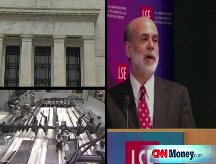Fed: Economy continues to sour
Central bank's Beige Book says the economy continued to deteriorate across the nation amid grim retail sales and depressed real estate markets.
NEW YORK (CNNMoney.com) -- Economic weakness continued to spread across the nation as real estate markets remained in distress and consumers kept their pocketbooks closed, according to the latest Federal Reserve report on regional economic conditions.
"Most districts noted reduced or low activity across a wide range of industries, although a few districts noted some exceptions in some sectors," the Fed said Wednesday in the January edition of its Beige Book.
The Beige Book, published eight times a year, is a summary of economic conditions in the central bank's twelve districts.
Wednesday's report noted that retail sales during the last six weeks, even during the heavily-discounted holiday period, were "generally weak," with eight of the 12 districts reporting "heavy discounting."
Meanwhile, the residential real estate market remained under pressure in most districts, with two-thirds reporting weak or declining home sales. Furthermore, home sale cancellations increased and new home construction declined.
Things were not much better in the commercial real estate market, with contacts in the Boston district calling the market "grim and depressing." And the New York district reported that Manhattan's office vacancy rate climbed to its highest level in two years.
While tight credit has impeded overall lending activity, refinancing of home loans increased in several districts, including Cleveland and Chicago, as mortgage rates have eased.
Overall lending activity softened as "credit quality remained a concern in several districts," according to the report.
Unemployment remains a concern with several districts reporting a "general weakening of labor market conditions." Layoffs, hiring freezes and reduced hours were reported in many districts.
Manufacturing activity continued to deteriorate in most regions. Half of the districts reported that businesses have reduced capital spending plans for the next six months.
Bucking the trend, defense and medical device manufactures reported some improvement in the Minneapolis district. And aerospace manufacturing in the San Francisco district held up, according to the report.
In another bright spot, lower energy prices were reported in several districts as oil and gas prices have plummeted from their July highs. And prices for raw materials fell, which resulted in lower input prices for manufacturers in the districts of Kansas, Atlanta and Boston.
Fed action: In response to the challenges facing the economy, which has been officially mired in recession since December 2007, the Fed has been on a drastic rate-cutting campaign.
Interest rate reductions are the central banks main tool for combating economic weakness and limiting the damage from the recession.
Last month, the Fed slashed its benchmark interest rate to a range between 0% and 0.25%, and said it expects to keep rates near that unprecedented low level for some time.
With its main tool nearly exhausted, however, the Fed has taken a number of unconventional steps to increase liquidity and loosen tight credit markets. The central bank launched a program aimed at buying up commercial paper - short-term corporate debt - in an effort to thaw the credit markets. It has also been considering buying long-term Treasurys to bring down mortgage rates.
The Fed's next policy-making meeting is slated for Jan. 27-28. The Beige Book is released two weeks ahead of those meetings.
On Tuesday, Fed chairman Ben Bernanke said that economic stimulus plans being discussed by the incoming Obama administration and the newly elected Congress "could provide a significant boost to economic activity." But he also warned that further bank bailouts may be necessary to bring about a sustained economic recovery. ![]()


